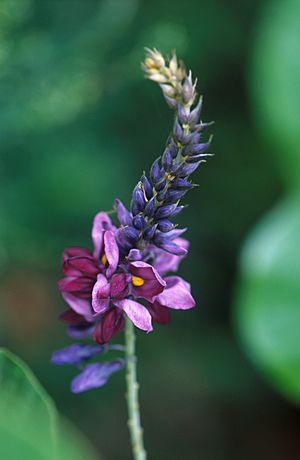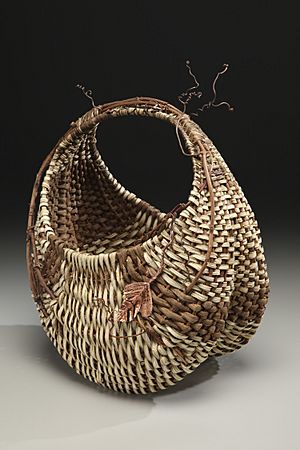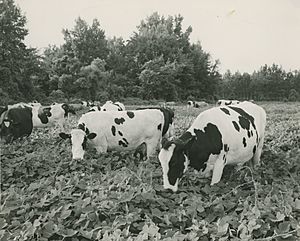Kudzu facts for kids
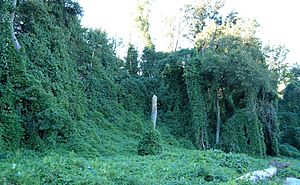
Kudzu (pronounced kood-zoo) is a group of fast-growing climbing plants. It's also known as Japanese arrowroot or Chinese arrowroot. These plants are native to East Asia, Southeast Asia, and some Pacific islands. However, in many other parts of the world, especially North America, kudzu has become an invasive species. This means it grows out of control and harms the local environment.
Kudzu vines climb quickly over other plants and trees. They grow so fast that they can cover and kill other plants by blocking out sunlight. Kudzu plants belong to the pea family, called Fabaceae. The name "kudzu" comes from the Japanese name for the plant, "kuzu." In places where kudzu has spread, it's often seen as a harmful weed. Even though it's edible, it's often sprayed with chemicals to control its growth.
Contents
What is Kudzu?
Kudzu is a name for several types of plants in the Pueraria group that are very similar. Some of these are seen as slightly different versions (varieties) of the same plant rather than completely separate species. For example, the kudzu found in the United States seems to have come from more than one of these types.
Here are some of the main types of kudzu:
- P. montana
- Pueraria montana var. chinensis
- Pueraria montana var. lobata
- Pueraria montana var. thomsonii
- P. edulis
- P. phaseoloides
How Kudzu Spreads
Kudzu spreads in a few ways. It can grow new plants from its stolons (runners) that root into the ground. It also spreads from rhizomes, which are underground stems.
Kudzu can also spread by seeds, though this is less common. The seeds are found in pods that ripen in the autumn. Each cluster of pods usually has only one or two seeds that can grow. These seeds have a hard coating and can stay alive for several years. They only sprout when the soil is very wet for about 5 to 7 days and the temperature is above 20°C (68°F).
Once a kudzu seed sprouts, the young plant needs lots of sunlight and soil that drains well but stays moist. Young kudzu plants are easily hurt by being moved or by chemical fertilizers. They don't do well in long periods of shade or in areas with too much water.
Uses of Kudzu
Helping Soil and Preventing Erosion
Kudzu has been used to stop erosion (when soil washes away) and to make soil better. Since it's a legume (like peas or beans), it adds nitrogen to the soil. It does this with the help of tiny bacteria that live on its roots.
Its deep roots also bring important minerals from deep underground up to the topsoil, making the soil richer. In parts of the Amazon basin in Brazil, kudzu has been used to improve clay soils, helping them hold more water for plants.
Food for Animals
Kudzu can be used to feed animals like livestock. It's good quality forage (food for grazing animals) and animals enjoy eating it. Animals can graze on kudzu until it freezes, and even a little after.
In the southern United States, kudzu was used to feed goats on land where other food was scarce. Kudzu hay (dried kudzu) has a lot of protein and nutrients. However, it doesn't produce a lot of food per acre compared to how fast it grows. It's also hard to make into bales because it's so viny and doesn't dry easily.
Making Baskets
The strong fibers from kudzu have been used for a long time to make art and baskets. The long runners and bigger vines are great for weaving. Some basket makers use the vines fresh, while others dry them and then soak them in hot water to make them flexible again. Both old and new artists use kudzu for their creations.
Plant Compounds and Traditional Uses
Kudzu contains special natural compounds called isoflavones. In traditional Chinese medicine, kudzu is known as gé gēn and is considered one of the important herbs. While it has been used for a long time, more scientific studies are needed to fully understand its effects in humans.
Food for People
The roots of kudzu contain starch, which has been used as a food ingredient in East and Southeast Asia for many years. In Vietnam, the starch is used to make a summer drink. In Korea, the root is made into a tea called chikcha and the starch is used in dishes like naengmyeon (cold noodles).
In Japan, the plant is called kuzu and the starch is called kuzuko. Kuzuko is used in desserts like kuzumochi and to thicken sauces, similar to how cornstarch is used.
The flowers of kudzu can be used to make a jelly that tastes a bit like grape jelly. The roots, flowers, and leaves also have properties that suggest they could be used in food. Bees sometimes collect nectar from kudzu flowers during dry periods, making a honey that can taste like grape jelly or bubblegum.
Folk Medicine
Kudzu has been used for centuries in East Asia as folk medicine, often in herbal teas. In Japan, kudzu powder is used to make an herbal tea called kuzuyu. There's also a traditional Chinese herbal drink called Kakkonto, which uses kudzu root and is meant for mild illnesses like headaches.
Other Uses
Kudzu fiber, also known as ko-hemp, has been used to make clothes and paper. It's also being looked at as a way to produce cellulosic ethanol, a type of fuel. In the Southern United States, kudzu is used to make soaps, lotions, and compost.
Kudzu as an Invasive Plant
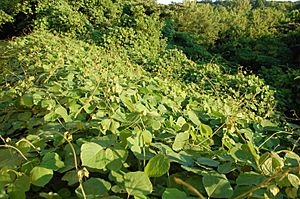
Kudzu causes environmental harm because it grows so fast that it takes over resources from other plants. It competes with native plants for sunlight, covering them and blocking the light they need to survive. This can cause the native plants to die.
When kudzu takes over an area, it changes the way dead leaves and plants break down. This can affect how much carbon the soil can store, which plays a role in climate change.
Kudzu in the Americas
Kudzu is a well-known problem weed in the United States, found in 32 states. It's very common along roadsides and in other disturbed areas, especially in the southeastern U.S. People often talk about how fast it spreads. Some estimates say it spreads by 150,000 acres (607 km²) each year, though other estimates are much lower.
Kudzu was first brought to the United States from Japan in 1876 for an exhibition in Philadelphia. It was also shown at the Chicago World's Fair. For a while, it was just a garden plant. But during the Dust Bowl era (1930s–1940s), it was promoted to farmers as a way to stop soil erosion. The government even paid farmers to plant it.
Road and rail builders also planted kudzu to stabilize steep slopes. A farmer and journalist named Channing Cope helped make it popular in the South. By 1943, his "Kudzu Club of America" had 20,000 members. However, when government payments stopped, much of the kudzu was removed. By the 1950s, the government stopped promoting it.
Kudzu's reputation for spreading incredibly fast might come from how visible it is, covering trees along sunny roadsides. Even with its fame, other invasive plants like Asian privet and invasive roses have actually caused more problems in the United States.
Kudzu in Europe
Since 2016, kudzu has been on a special list in Europe called the "List of Invasive Alien Species of Union concern." This means it cannot be brought into, grown, moved, sold, planted, or purposely released into the environment anywhere in the European Union.
Kudzu in Other Regions
During World War II, kudzu was brought to Vanuatu and Fiji by the United States Armed Forces. It was used as camouflage for equipment and has since become a major weed there.
Kudzu is also becoming a problem in northeastern Australia, and has been seen in Switzerland and parts of Northern Italy. In New Zealand, kudzu was declared an "unwanted organism" in 2002.
Controlling Kudzu
Removing the Crown
To control kudzu for a long time, you don't need to destroy its entire deep root system. It's enough to kill or remove the kudzu root crown and any rooting runners. The root crown is a tough, lumpy part of the plant that sits on top of the roots. It forms where many vines root to the ground and can be as small as a pea or as big as a basketball.
The older the crown, the deeper it is in the ground. All kudzu vines grow from these crowns and nodes (points where leaves and stems grow). If even a small part of a root crown is left, the kudzu plant can grow back.
One way to control kudzu is to cut the crowns off the roots, usually just below the ground. This kills the plant right away. Just cutting the vines above ground isn't enough to kill it quickly. It's also important to destroy all removed crown material, as buried crowns can regrow. Moving crowns in soil from an infested area is a common way kudzu accidentally spreads to new places.
Cutting the plant very short every week, letting animals graze on it heavily for many years, or repeatedly tilling the soil can also work. These methods wear out the plant's stored energy. If you cut the vines in the spring, you'll need to do it again. The plant uses up its stored food trying to regrow. Harvested kudzu can be fed to animals, burned, or composted.
Some cities in the United States, like Chattanooga, Tennessee, have tried using goats and llamas to eat the kudzu. Similar efforts have been made in Winston-Salem, North Carolina, and Tallahassee, Florida.
Using controlled fires on old, large kudzu patches can remove the plant cover and help seeds sprout, making them easier to remove or treat. Fire itself doesn't kill kudzu effectively, but it clears the way for equipment to remove the crowns with less disturbance to the soil.
Using Herbicides
A special chemical called a herbicide, like glyphosate, triclopyr, or picloram, can be put directly on cut kudzu stems. This helps the chemical travel into the plant's large root system and kill it. Herbicides can be used after other control methods like mowing, grazing, or burning, which can weaken the plants and make the chemicals work better. For very large areas in forests, herbicides that work in the soil have been very effective.
After the first chemical treatment, you usually need to do follow-up treatments and check the area. This is especially true if the kudzu has been growing there for a long time. It might take up to 10 years of checking to make sure the plant doesn't come back.
Using Fungi
Since 1998, scientists in the United States have been experimenting with using a fungus called Myrothecium verrucaria to fight kudzu. This fungus can be used as a natural herbicide. A spray made from this fungus works in different conditions, even when there's no dew. It causes little harm to other woody plants in areas where kudzu grows and works quickly. Kudzu treated in the morning can show damage by the afternoon.
Images for kids
Error: no page names specified (help). In Spanish: Kudzu para niños
In Spanish: Kudzu para niños


